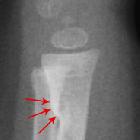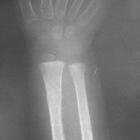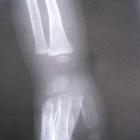inkomplette Frakturen im Kindesalter








Incomplete fractures are a heterogeneous group of fractures that predominantly occur in the long bones of pediatric patients. Rang describes a continuum of fractures that occur with increasing longitudinal force applied along the length of the bone. At the point where force exceeds the structural integrity of the bone, a complete fracture occurs.
The majority of forearm and lower leg fractures occur after indirect injury (e.g. the fall on an outstretched arm or jump from a height) rather than a direct injury (e.g. strike with a bat). In these situations, the force applied and the angulation of the force results in a variety of injuries.
Classification
With low energy impact, a longitudinal force is applied down the radius will result in bowing which, when the force is released returns to normal; the force results in elastic bowing that is not radiographically apparent since, by the time the film is obtained, the bone has returned to normal.
Bowing fracture
With greater force, the loaded bone undergoes plastic deformation resulting in clinically evident and radiographically proven bowing of the bone - a bowing fracture.
Torus fracture
If more force were applied the concave side of the bending bone would undergo compression fracture and a bulge would appear - a torus fracture. These usually occur in the metaphyseal regions, especially of the distal radius.
Greenstick fracture
If the bending bone is angulated slightly beyond its limit of bending, there is a complete failure of the convex cortex (the side of maximal tension) and only bending on the compression side. These greenstick fractures are far less common than torus fractures and are often more complete than initial radiographs demonstrate. Greenstick fractures tend to be mid-shaft injuries and may result from direct perpendicular trauma.
Siehe auch:
und weiter:

 Assoziationen und Differentialdiagnosen zu inkomplette Frakturen im Kindesalter:
Assoziationen und Differentialdiagnosen zu inkomplette Frakturen im Kindesalter:

